In Spring I was curious about a plant that looked like a strawberry plant, so I dug up a couple of these weeds and put them in a flower bed. That way I could keep an eye on them and see what they developed into.
Right away I decided they weren’t strawberries because the stem was thick and upright, hairy, too. It also started to branch out.
Strawberry plants have only basal leaves and are vining in their growth habit, not upright and branching. Each strawberry plant sends out runners that reach about a foot away from the mother plant and put down roots to develop another strawberry plant. We have some ever-bearing strawberries, called Ozark Beauty, that are ripening another set of berries right now.
The flowers of my weed are five-parted and yellow, but sort of inconspicuous because the petals tend to curl in a bit. It turns out that my weed is called Rough Cinquefoil, Potentilla norvegica.
Identifying the plant was easy using these characteristics: 5 regular parts, yellow flower, hairy, thick stem, and alternate, palmately divided leaves in threes. Also, the plant gets to be 1-3 ft tall and spreads to 4-6 ft across – much larger than any strawberry plant.
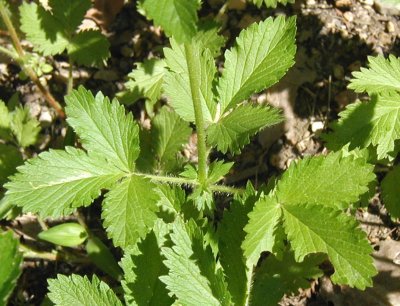
Strawberry-like leaves of rough cinquefoil in threes. Note the hairy stems. Photo taken 16 June 2008.
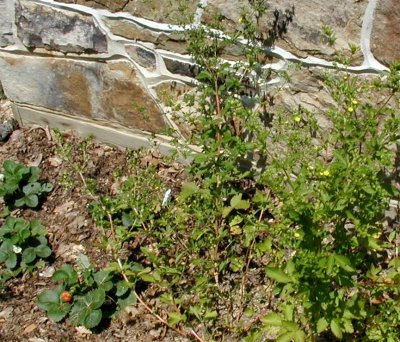
Strawberry plants on the left are low to the ground, while the much larger rough cinquefoil plants grow two or three feet tall with some stems laying onto the ground.
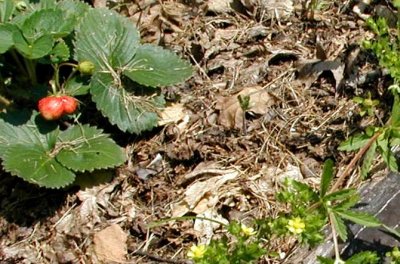
Strawberry leaflets on the left are much broader than the narrow rough cinquefoil leaflets on the right.
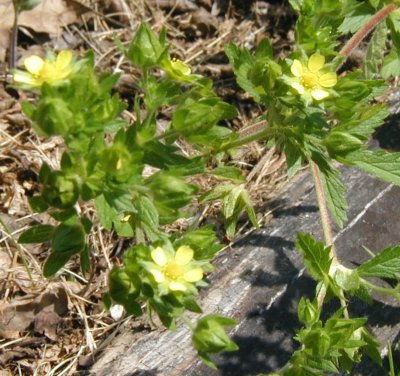
Only a few small bright yellow flowers of rough cinquefoil are open at a time and they last for about a day.
There is apparently no medicinal or edible interest in the rough cinquefoil, so it’s history in the wildeherb garden.
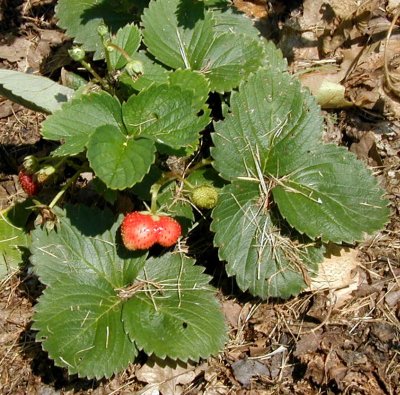
Now that I’ve decided to pull out the rough cinquefoil, those Ozark Beauties will have a little more room to send out their runners. Next year we should have a larger harvest of strawberries.
Thank you so much… a mystery of a few years now has finally been solved! I thought I would stop a moment while working in my garden today to once and for all find out what this plant is. Again, thank you! (Now I will have to decide whether it is something I would like to keep growing there : )
Hey Janet,
Just so you know, the rough cinquefoil is a perennial and unless you dig it out, if you decide to go that way, it is likely to come back yearly. The plant that was photographed in ’08 is still returning five years later. It’s bushier and larger this year than I’ve noted before. If you like it, enjoy it!
Just be aware this is very invasive once it becomes established.
Thank You for the info. It didn’t take long to find. I guess my description of the plant was good. I think I will dig it out since it is so invasive.
Hi Rose,
I would surely dig out that rough cinquefoil, too. It really does look ‘weedy’ doesn’t it? Now, the next time you come across it you’ll know what to do – get the shovel!
Thanks for sharing your experience.
This weed will produce hundreds to thousands of tiny seeds on each plant, even in the first year. The seed pods open easily and drop seeds all summer and fall. In no time at all, you will have these weed plants EVERYWHERE. Get them pulled as soon as they begin to grow!
Hi Lori –
Thanks for your input. I agree totally. Not one for the flower bed – even for curiosity sake! Sometimes I do have to learn the hard way. 🙂
Is it weird that I did exactly the same thing this year; I dug out up and transplanted it to my strawberry raised bed?
Totally weird! Hope you took it out already!
Destroyed my raised bed in 1 year where it came from beats me my bed was 609 mm high and built only 2 year ago with fresh compo and soil dug every thing out fingers crossed
Ouch, John! I guess you can blame a bird or the wind for dropping a few seeds into your bed. If I were you, I’d inspect that bed for any “babies” popping up this Spring so you can remove them before they get any bigger.
Good luck!
Thanks for the ID! I have tons of this in my lawn. luckily it is easy to pull out.
You’re welcome, Robyn.
We have lots of Common Cinquefoil too. It spreads by runners and the roots aren’t deep, so when you aggressively pull up one “plant” a few others will come along for the ride. I was very glad the rough cinquefoil was easy to get rid of just by pulling it out. The main differences between the two plants are that the common cinquefoil, Potentilla simplex, grows low to the ground and has five-poarted leaves while the rough cinquefoil has three-parted leaves and grows tall. The flowers are similar in shape but the rough cinquefoil ones are a much lighter yellow.
Whatever you call them, neither one will grow a strawberry! We do enjoy seeing the bright golden yellow flowers of the common cinquefoil in Spring, so some of that gets to stay at the edge of the lawn.
sorry folks, mine not only have lots of flowers on them, they are carrying fruit, also. The flowers have been blooming for quite a while. Just for info
That’s neat, Renee. Would love to see a pic of the fruit!
Great comments. A special thank you to Renee from the plant of mine she saved. I transplanted it from a young, which at first lies flat, that’s when it what most resembles a strawberry. I’m growing it inside, and set it out in the rain, if gentle. I was ready to yank it out and otherwise utilize the prime real estate. Would be great if it flowered, I’ll get it outside for the bees. The leaves exuded a crystalline substance in its early stage, before and, after stess of transplanting exuded again a second time. Substances on plants like that may have medicinal purposes. It suffers a bad reputation, though, probably for being as it seems, a tenacious weed.
Hey, I’m curious about the crystalline substances on the plant leaves…why do you think they may have medicinal purposes? An, why are you growing this “weed” inside? Do tell!
Greetings Wilde, so much for my medicinal theory, lol:
“Plants have a crystal formation called raphides which are the chemical compound calcium oxalate crystal. It is a poisonous substance of the plant that can cause soreness and numbness when ingested.”
I put the plant in a pot to isolate it in case it wasn’t a strawberry. There were several smaller ones popping up nearby (which have since gone to the great beyond). I would have left it in a pot but a hail storm hit so I brought it in, and have left it.
If it blooms I’ll put it outside. If it fruits like Renee’s, I’ll let you know.
Great follow up, Free.
Raphides, that may be the plant’s way of protecting itself from predators. When an herbivore eats a leaf with those calcium oxalate crystals present, its mouth or esophagus can be scratched causing soreness and therefore prevent it from consuming the whole plant. It’s interesting that you observed the crystals during the young plant growth stage and after the trauma of being transplanted. Probably both times the plant is quite vulnerable to predation.
Do let us know if your plant blooms and sets fruit. Thanks!
It seems that this is the culprit that has sprung up in my garden after applying mulch! I’ll def not be buying mulch from the same garden centre next year.
Hey Tanya,
I guess there are tons of places to get mulch from so you don’t have to stick with that garden center. Hopefully, you’ll find a reliable one. Writing to us from Australia? Welcome!
Your weed issue brings up a point with compost piles. Don’t put seeds in there! Any plants that you don’t want to spread around shouldn’t go in the compost if they’re near seed production time. That’s just asking for more weeds to pull and who has time for that? Instead burn them if you can. At least that’s what we do here on the mountain.
can this annoying plant be killed by weed killer by a professional? I just noticed mine in the yard last year. I knew right away this wasn’t a strawberry plant. I dug all up last year and find they are returning this year. I hope a professional can help me get rid of this aggressive WEED. Ugh.
Hey Lynn,
Please go out and pull out the weeds by hand. It won’t take that long! Besides, you need a little sun and activities to be healthy, just like me and everyone else, right?
Spraying weed killer is causing all sorts of problems in the world these days. If you have pets or children, refrain at all costs!
Thanks for the info, found some when cleaning my flower bed, tasted the ‘berry’ not tastey not a strawberry ! yes i can see it has ivasive tendencies.
Hey Jimmie!
I see a bunch of these little wild berries growing near my garden and I pull them out as yes they are invasive and want to take over.
I do wonder who eats them. Birds? Turtles? Chipmunks? So far I haven’t spotted whoever tastes them and leaves a few half-eaten.
Thanks for chiming in!